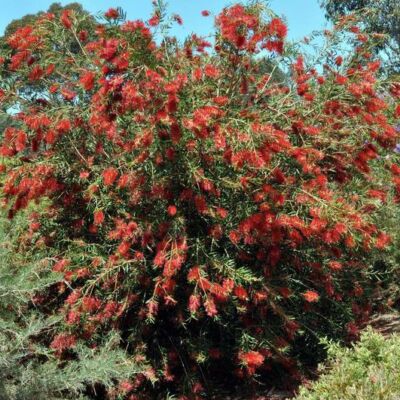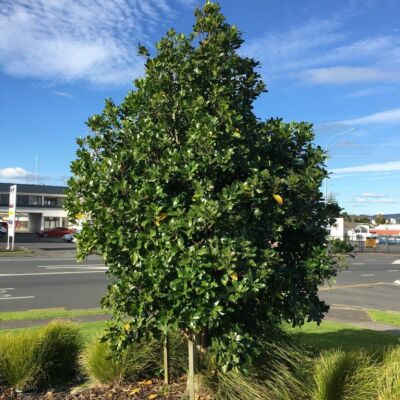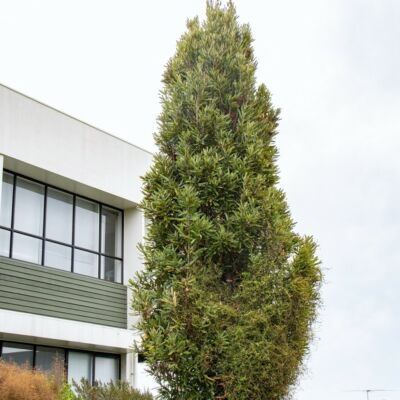|
A quick growing, smaller, spreading tree. Rich green, ferny leaves. Flowers during summer on top of leaves, open as rounded fluffy brushes of pink. Tolerates hot dry areas once established. Excellent shade tree. |
| Height x Width | 5 x 4 |
| Height Range | Medium 5-10m |
| Growth Rate | Fast |
| Plant Type | Tree |
| Shape / Habit | Spreading |
| Country of Origin | Asia, China |
| Similar to Consider | Jacaranda, Gleditsia, |
|
|
| Leaf Colour | Green |
| Deciduous Leaf Colour | Brown |
|
|
| Flower Colour | Pink |
| Fragrant? | No |
|
|
| Specimen | Yes |
| Good Shade Tree? | Yes |
| Note: Growth, height and information are given in good faith but are subject to natural variables beyond our control. | |
Few things transform a landscape like a tree in full bloom, from the bold and dramatic Magnolias and Rhododendrons to the subtle, dainty Pea-shaped flowers of the Cercis family all add a seasonal lift to the garden. Black Bridge Nurseries stock a huge and diverse range of flowering trees suitable for every purpose.
“Say it with flowers”.
-
-
Apple TREES are cultivated worldwide and are the most widely grown species in the genus Malus. The apple is a deciduous tree, generally standing 2 to 4.5m tall having its origins in Central Asia. When cultivated, the size, shape and branch density are determined by rootstock selection and trimming method. LEAVES are dark green simple ovals with serrated margins. Blossoms are produced in spring at the same time as leaves. FLOWERS are generally white with a pink tinge. The FRUIT matures in late summer or autumn. Different CULTIVARS are bred for various tastes and use, including cooking, eating raw and cider production. Sometimes hand thinning is necessary to avoid overstressing the tree, which may result in a poor crop the following year. However this should not be done until mid-December when the natural fall is complete. ROOTSTOCKS are used to control speed of growth and the size of the resulting tree allowing for easier harvesting. Apple Root Stock: M26: Very Dwarf tree, Under 3.0m M.9 Dwarf tree, To Apx 3.0m, Suits well drained fertile soils. Requires support system: MM106 Semi dwarf tree, To Apx 4.5m. Good on most soils except poorly drained soils MM 793 Larger tree, To Apx 6.0m. Better suited to difficult soils (heavy or clay) Northern Spy Semi dwarf tree. To Apx 3-5m. Wetter ground and Clay. Resistance to woolly aphids. Harvest Season (Apx): EARLY = Jan – Feb. MID = Feb – March. LATE = April – May Make enquiries as to which varieties we have available now or see our online catalogue.
-
Originally domesticated in China, apricots are grown successfully around the world. These small TREES are a manageable size for the home orchard growing to around 4-5m tall. FLOWERS appear in spring with FRUIT (a drupe similar to a small peach, ranging in colour from yellow to orange) ready to harvest Dec - Feb. As they are self fruiting, you typically don't need two apricot trees to produce fruit. They are relatively easy to grow and will produce loads of fruit year after year that can be enjoyed fresh from the tree, made in to jam, bottled or dried. Apricots we supply are better suited to warmer climates. HARVEST is from Dec - Feb. Make enquiries as to which varieties we have available now or see our online catalogue.
-
A handsome, fast growing, subtropical evergreen TREE with large emerald green LEAVES that forms a thick canopy. FLOWERS September to December. FRUIT range in size and shape from round cannonball to pear like. All varieties are self-fertile though the trees will produce more and better fruit if cross pollinated. To get fruiting trees it is highly recommended to get a grafted tree and then generally require a few years to mature before fruiting. Stone grown trees may not produce fruit. Requires free draining deep soil and protection from frosts and cold winds. HARVEST September to April. from Grows Apx 6 x 4m. Make enquiries as to which varieties we have available now or see our online catalogue.
-
- Description
A vigorous small tree with long, narrow green leaves with slightly pendulous branches. Bright red flower spikes carried in clusters over spring and early summer provides nectar for bees and birds. Tolerates coastal, wind, clay, sandy or dry once established. Height x Width 3 x 2 Height Range Small 1-5m Growth Rate Fast Plant Type Tree Shape / Habit Round Country of Origin Australia Similar to Consider C. Red Clusters, Salignus (Yellow) Citrinus Violetii (Violet) - Leaf
Leaf Colour Green - Flower
Flower Colour Red Fragrant? No - Uses
Screening / Shelter Yes Hedging Yes Bird Feeding Yes Note: Growth, height and grade information are given in good faith but are subject to natural variables beyond our control. -
- Description
Vigorous large shrub, new leaves emerge a silvery-pink turning to mid- green. Masses of red bottlebrush flowers with gold anthers appear in spring and autumn. Tolerant of poor dry soils once established, though prefers some moisture. Provides nectar for bees and birds. Good for hedging. Height x Width 3 x 2 Height Range Small 1-5m Growth Rate Moderate Plant Type Shrub Shape / Habit Round Country of Origin Australia Similar to Consider Kings Park Special, Salignus (Yellow) Citrinus Violetii (Violet) - Leaf
Leaf Colour Green - Flower
Flower Colour Red Fragrant? No - Uses
Screening Yes Hedging Yes Bird Feeding Yes Fruit Producing Note: Growth, height and grade information are given in good faith but are subject to natural variables beyond our control. -
- Description
Pure white medium semi-double. Slight fragrance early season. Upright rounded form. Trims well so ideal for hedging and topiary. Plant in full sun or dappled shade in well drained acidic soil. Prune after flowering to maintain shape. Height x Width 2.5 x 2.0 Height Range Small 1-5m Growth Rate Moderate Plant Type Shrub Shape / Habit Round Country of Origin China Similar to Consider Other Camellias, Laurus Nobilis, Prunus lusitanica, Michelia Figo, Syzygium resilience, Pittosporums, Corokia, Griselinia, Ficus, Ilex largo, Olea El Greco, Eugenia Ventinatii - Leaf
Leaf Colour Green - Flower
Flower Colour White Fragrant? Yes - Uses
Hedging Yes Note: Growth, height and grade information are given in good faith but are subject to natural variables beyond our control. -
- Description
A small open habit tree with a broad round head. Heart shaped leaves are purple red and appear after the magenta flowers bloom on bare branches in early spring. Excellent small specimen tree suited to smaller gardens. Tolerates Clay soil but avoid wet or poorly drained soils. Deciduous. Height x Width 4 x 3 Height Range Small 1-5m Growth Rate Moderate Plant Type Tree Shape / Habit Spreading Country of Origin North America Similar to Consider Prunus Thundercloud, Fagus Riversii, Fagus Sylv Purp, Acer Tamuke Yama, Fraxinus Raywoodii, Acer Bloodgood. - Leaf
Leaf Colour Purple Red Deciduous Leaf Colour Purple Red - Flower
Flower Colour Magenta Fragrant? No - Uses
Specimen Yes Accent Yes Note: Growth, height and information are given in good faith but are subject to natural variables beyond our control. -
- Description
Cordyline australis - Cabbage Tree Cabbage tree: An iconic New Zealand palm like tree. Long drooping slender leaves up to 1m long are clustered at the tips of the branches. Large heads of scented creamy white flowers in Nov produce nectar for bees, then fruit attracts birds from January-April. Commonly found throughout farmland, open places, wetlands and scrubland of the North and South Islands in anything from wet swampy ground to dry windy hill slopes. Hardy. Height x Width 6 x 2 Height Range Small 1-5m Growth Rate Slow Plant Type Palm Shape / Habit Upright Country of Origin New Zealand Similar to Consider Nikau Palms - Leaf
Leaf Colour Green - Flower
Flower Colour White Fragrant? Yes - Uses
Accent Yes Bird Feeding Yes Note: Growth, height and grade information are given in good faith but are subject to natural variables beyond our control. -
- Description
A slender growing shrub with rich green foliage and masses of starry yellow flowers early summer followed by dark red berries. Attracts birds. Ideal as a hedge trims well. Will tolerate dry coastal exposed or windy sites once established. Height x Width 2 x 1.2 Height Range Small 1-5m Growth Rate Moderate Plant Type Shrub Shape / Habit Round Country of Origin New Zealand Similar to Consider Syzygium resilience, Michelia Figo, Camellias, Pittosporums, Griselinia, Ficus, Ilex largo, Olea El Greco, Eugenia Ventinatii - Leaf
Leaf Colour Green - Flower
Flower Colour Yellow Fragrant? No - Uses
Hedging Yes Bird Feeding Yes Note: Growth, height and grade information are given in good faith but are subject to natural variables beyond our control. -
- Description
A moderately fast-growing tree with large glossy green leaves. Small creamy-green flowers in September followed by large orange fleshy drupes in December. Very hardy withstanding strong winds coastal conditions and drought. An excellent specimen tree able to be trimmed to shape. Height x Width 15 x 8 Height Range Tall 10+ Growth Rate Moderate Plant Type Tree Shape / Habit Round Country of Origin New Zealand Similar to Consider Alectryon Excelsa, Planchonella Costata, Magnolia grandiflora types, Vitex Lucens - Leaf
Leaf Colour Green - Flower
Flower Colour Cream Fragrant? No - Uses
Specimen Yes Good Shade Tree? Yes Screening / Shelter Yes Bird Feeding Yes Note: Growth, height and grade information are given in good faith but are subject to natural variables beyond our control. -
- Description
A small tree with a symmetrical habit. Long glossy light green leaves. Unusual yellow / green papery flower clusters in summer. Purpureum has red purple leaves and light red flowers. Will tolerate dry sandy or rocky soils, salt spray, windy areas and drought conditions. Ideal used as a wind or privacy screen and is useful in harsh conditions. Keep trimmed to maintain shape. Height x Width 3.5 x 2.0 Range Small 1-5m Growth Rate Fast Plant Type Tree Shape / Habit Spreading Country of Origin New Zealand Similar to Consider D. Purpurea. Myrsine salicina, Planchonella costata, - Leaf
Leaf Colour Green - Flower
Flower Colour Yellow green Fragrant? No - Uses
Screening / Shelter Yes Hedging Yes Note: Growth, height and grade information are given in good faith but are subject to natural variables beyond our control. -
A smaller growing bushy TREE it is one of the hardiest of the subtropical fruits, growing in most soils and tolerating several degrees of frost. Feijoas are commonly available as seedlings, but plants grown from cuttings or grafted specimens are more reliable. Attractive red and white FLOWERS also attract birds and are edible as well. FRUIT ripens between April and May and when mature will fall off the tree at a touch. The skin is green and ranges from smooth to rough and dimpled. The pulp is sweet and juicy with a good flavour. Generally require another to cross pollinate although "Unique" is unique in that it doesn't! They respond well to trimming if they become a little tall or woody and can also be used as a hardy hedge. APX: 4.0m - HARVEST: March-May Make enquiries as to which varieties we have available now or see our online catalogue.
-
- Description
A quick growing small ornamental tree with dark green smooth leaflets. Masses of flowers in large loose, fragrant panicles in spring almost covering the entire tree. Requires shelter in exposed areas. Easily clipped to shape. Evergreen, but can be semi-deciduous in colder areas. Height x Width 7 x 4 Height Range Medium 5-10m Growth Rate Fast Plant Type Tree Shape / Habit Round Country of Origin Asia Similar to Consider Radermacheria, Alectryon Excelsa, Myrsine Salicina, - Leaf
Leaf Colour Green - Flower
Flower Colour White Fragrant? No - Uses
Specimen Yes Good Shade Tree? Yes Screening / Shelter Yes Note: Growth, height and grade information are given in good faith but are subject to natural variables beyond our control. -
- Description
Neatly rounded tree with a pretty branch pattern. Lacy double pinnate foliage lime-yellow in spring deepening to fresh green in summer bright yellow in autumn. Successive new growth through summer provides a contrast to the older leaves. Great lawn or specimen tree. Height x Width 6 x 5 Range Medium 5-10m Growth Rate Moderate Plant Type Tree Shape / Habit Umbrella Country of Origin Central North America Similar to Consider Robinia Freesia, Ginkgo, Acer Kellys Gold, Albizzia, Jacaranda - Leaf
Leaf Colour Green yellow Deciduous Leaf Colour Bright yellow - Flower
Flower Insignificant - Uses
Specimen Yes Good Shade Tree? Yes Accent Yes Note: Growth, height and grade information are given in good faith but are subject to natural variables beyond our control. -
- Description
Graceful evergreen with slender branches and fresh light green leaves, semi-glossy, veined and sharply toothed. From late summer through to autumn it conceals its foliage with masses of beautiful, starry, snow-white flowers. Excellent rapid screening. NZ Native Height x Width 5 x 3 Range Small 1-5m Growth Rate Fast Plant Type Tree Shape / Habit Round Country of Origin New Zealand Similar to Consider Planchonella costata, Alectryon Excelsa, - Leaf
Leaf Colour Green - Flower
Flower Colour White Fragrant? No - Uses
Good Shade Tree? Yes Note: Growth, height and grade information are given in good faith but are subject to natural variables beyond our control. -
- Description
An outstanding flowering tree. Graceful, erect, open form tree with handsome foliage and rich, creamy yellow fragrant flowers in spring early summer. Trim to keep in shape and bushy. Height x Width 10 x 4 Height Range Medium 5-10m Growth Rate Fast Plant Type Tree Shape / Habit Upright Country of Origin Australia Similar to Consider Hoheria Populena, - Leaf
Leaf Colour Green - Flower
Flower Colour Yellow Fragrant? Yes - Uses
Specimen Yes Note: Growth, height and grade information are given in good faith but are subject to natural variables beyond our control. -
- Description
A beautiful fast growing small tree with dainty ferny foliage. A very spectacular sight in early summer when soft purple flowers cover the tree. Has open irregular head with branches going in all directions! Height x Width 8 x 5 Height Range Medium 5-10m Growth Rate Fast Plant Type Tree Shape / Habit Round Country of Origin South America Similar to Consider Albizia, Gleditsia - Leaf
Leaf Colour Green Deciduous Leaf Colour Copper Brown - Flower
Flower Colour Purple Fragrant? No - Uses
Specimen Yes Good Shade Tree? Yes Accent Yes Note: Growth, height and grade information are given in good faith but are subject to natural variables beyond our control. -
- Description
Slender, erect, tapering tree with long green serrated leaves. Tubular reddish brown flowers in spring attractive to native birds. Ideal tree for smaller gardens and narrow spaces. Ok in coastal gardens. Avoid phosphate fertilizers. Height x Width 7 x 3 Height Range Medium 5-10m Growth Rate Moderate Plant Type Tree Shape / Habit Pyramidical Country of Origin New Zealand Similar to Consider Liriodendron tulipifera fastigiata, Olea El Greco, Dacrydium Cuprissinum, Acer Bowall, Poplar crow’s nest, Quercus robur fastigiata, Carpinus Betulus fastigiata, Dacrycarpus Dacrydoidies - Leaf
Leaf Colour Green - Flower
Flower Colour Red Fragrant? No - Uses
Specimen Yes Accent Yes Bird Feeding Yes Note: Growth, height and grade information are given in good faith but are subject to natural variables beyond our control. -
- Description
A Fast growing spreading tree of varying form. Tiny needle like leaves are softer to touch than Manuka. In During summer small white flowers smother the tree giving an almost snow covering effect. Very attractive to bees. Larger growing tree than Manuka. Seeds smaller than Manuka. Will withstand windy coastal conditions, or dry soils once established. Height x Width 6 x 4 Height Range Medium 5-10m Growth Rate Fast Plant Type Tree Shape / Habit Round Country of Origin New Zealand Similar to Consider Leptospermum scoparium - Leaf
Leaf Colour Green - Flower
Flower Colour White Fragrant? No - Uses
Hedging Yes Bird Feeding Yes Note: Growth, height and grade information are given in good faith but are subject to natural variables beyond our control.



















